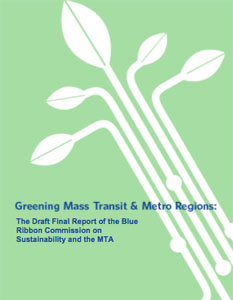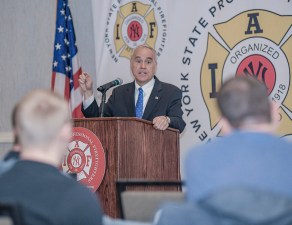Quick Impressions of the MTA’s Sustainability Report
 This afternoon the MTA released a draft of its eagerly anticipated sustainability report, which has been in the works since September 2007. The product of a "blue ribbon commission" featuring heavy hitters in the transportation world, the report reads like the MTA’s version of NYCDOT’s "Sustainable Streets" strategic plan.
This afternoon the MTA released a draft of its eagerly anticipated sustainability report, which has been in the works since September 2007. The product of a "blue ribbon commission" featuring heavy hitters in the transportation world, the report reads like the MTA’s version of NYCDOT’s "Sustainable Streets" strategic plan.
Much of the report deals with making the MTA’s own operations more energy efficient, but the overriding message is that transit is inherently an instrument of sustainability: The agency can be at its greenest by extending access to transit, expanding capacity, improving performance, and ensuring that new development is transit-oriented.
I’ve combed through the synopsis of the report [PDF], and the legislative agenda it lays out does not skimp on ambition. The policy recs run the gamut from the current federal stimulus package to state legislation on bus enforcement cameras to New York City parking meter rates. It hits several items on the livable streets agenda and should prove to be a useful barometer of progress going forward. The major takeaway: New Yorkers and others who rely on the MTA need legislators to step up and deliver on these sustainability goals.
I’m still working through the full report, but I can say that it heats up on page 53 of this PDF, with "Transformational Recommendations" for smart growth and transit-oriented development in the region. Highlights from that section posted after the jump.
Smart Growth/TOD Working Group: Top Recommendations
- The MTA should capture two-thirds of all new vehicle miles traveled (VMT) generated within its region through 2030. To achieve this, the MTA should advise communities and collaborate with them on how to create and expand feeder and distributor lines and eliminate gaps in the regional transit network.
- The MTA should promote clustered development throughout its region, seeking to draw two-thirds of all new development to within a quarter-mile to a half-mile of transit access within the MTA network.
- The MTA should take the lead in closing the "last mile" transportation gap by improving access to transit through robust, flexible feeder and distributor services, as well as pedestrian and bike improvements.
- The MTA should develop a systemwide TOD program that articulates principles and guidelines for TOD project development and should assist communities, developers and stakeholders throughout the region in planning these community-based initiatives.
